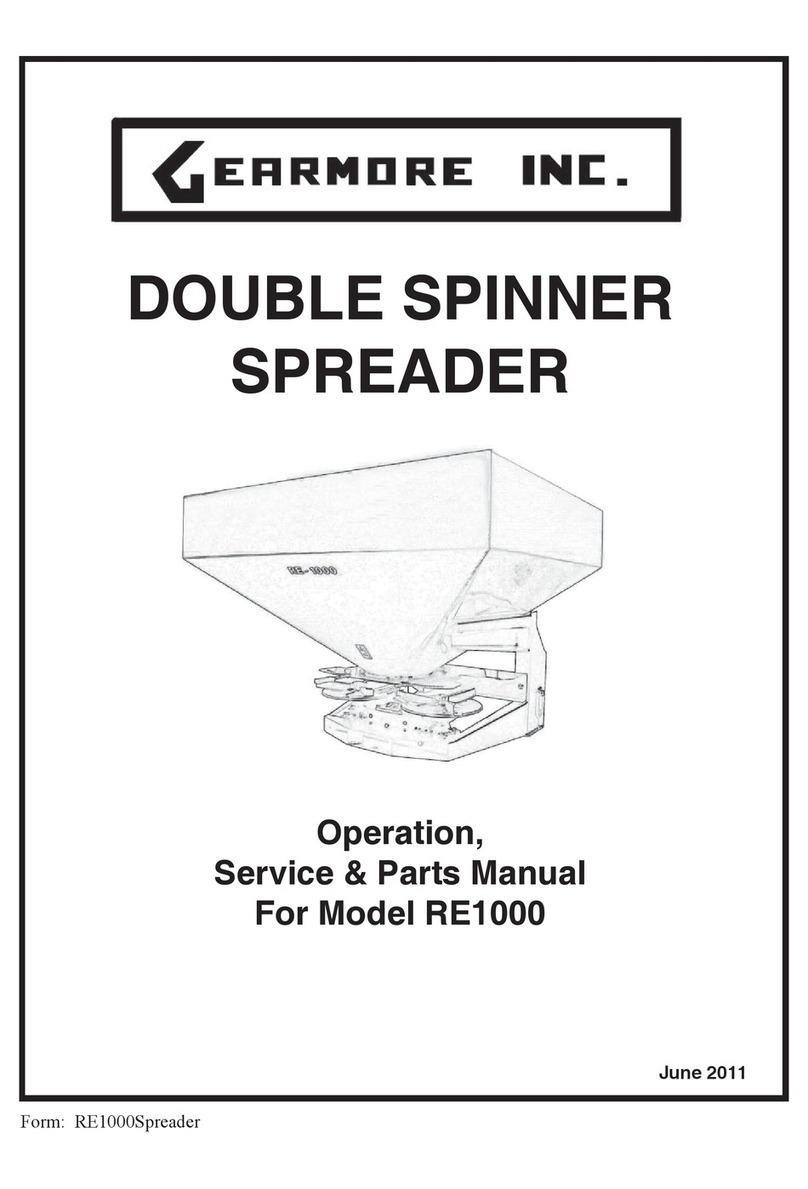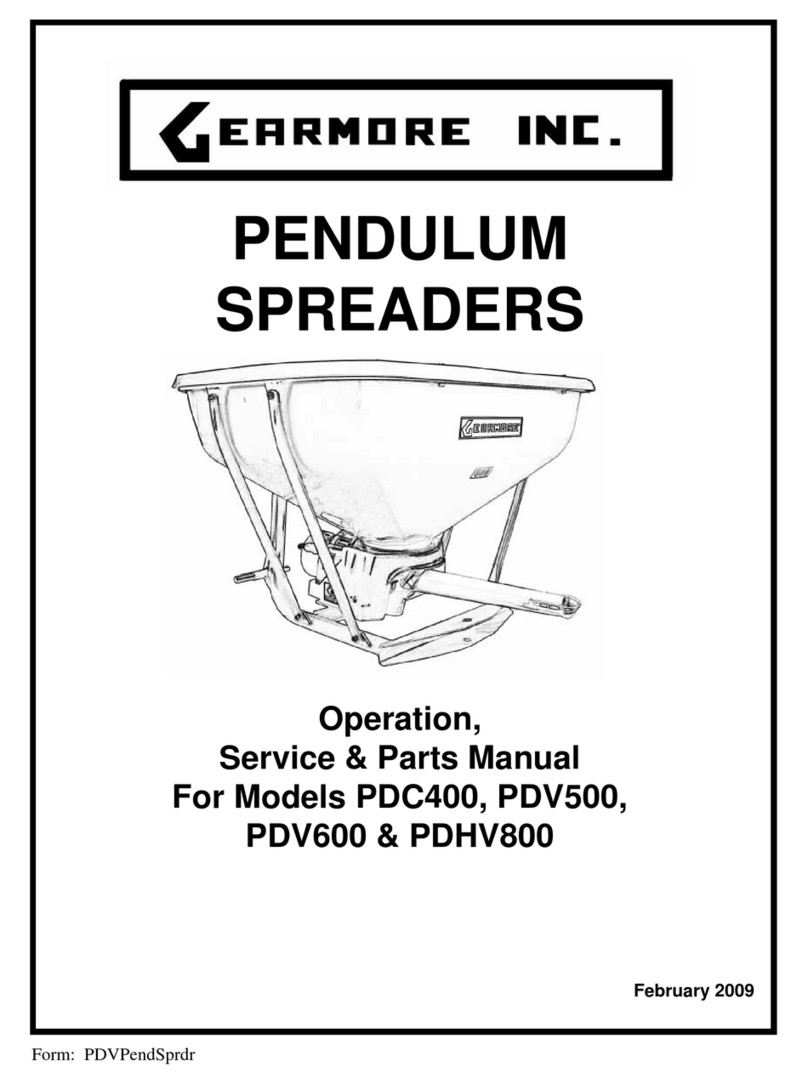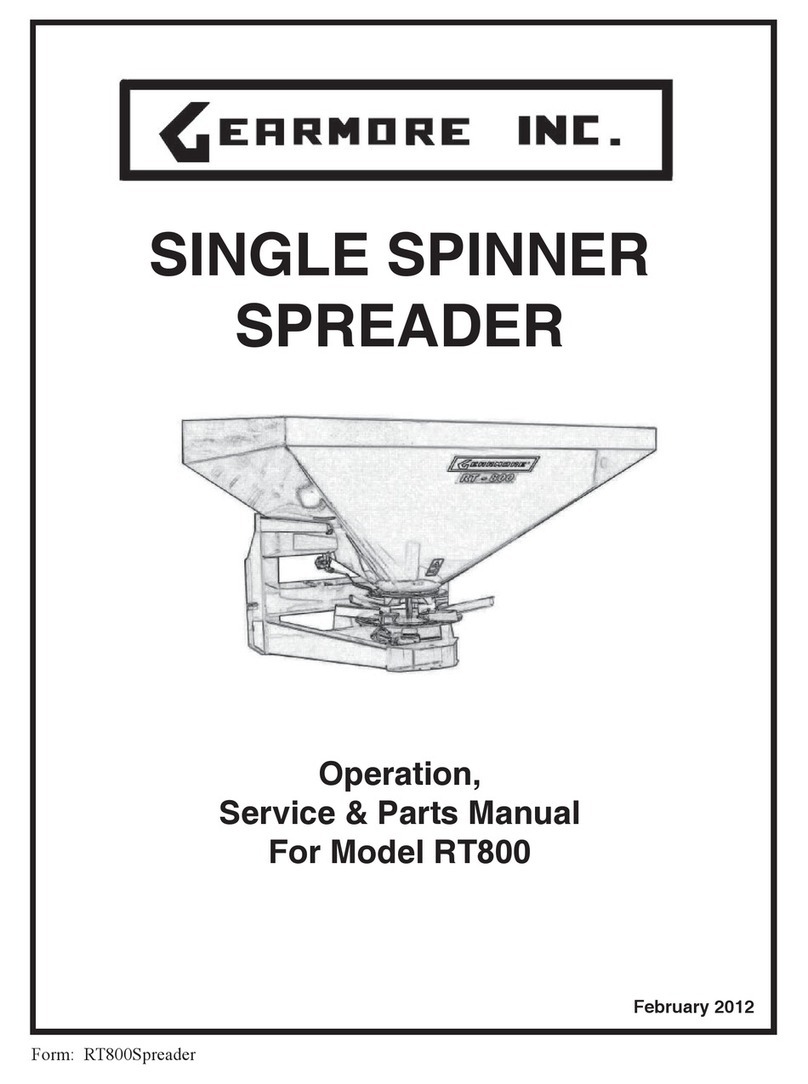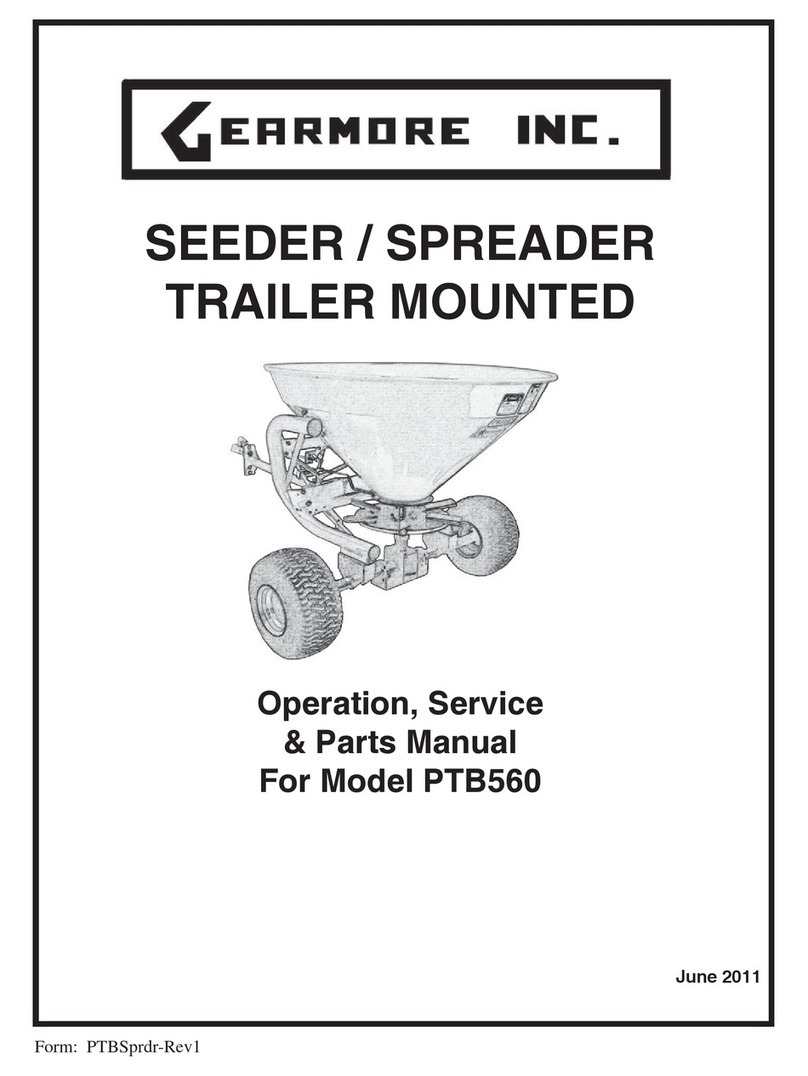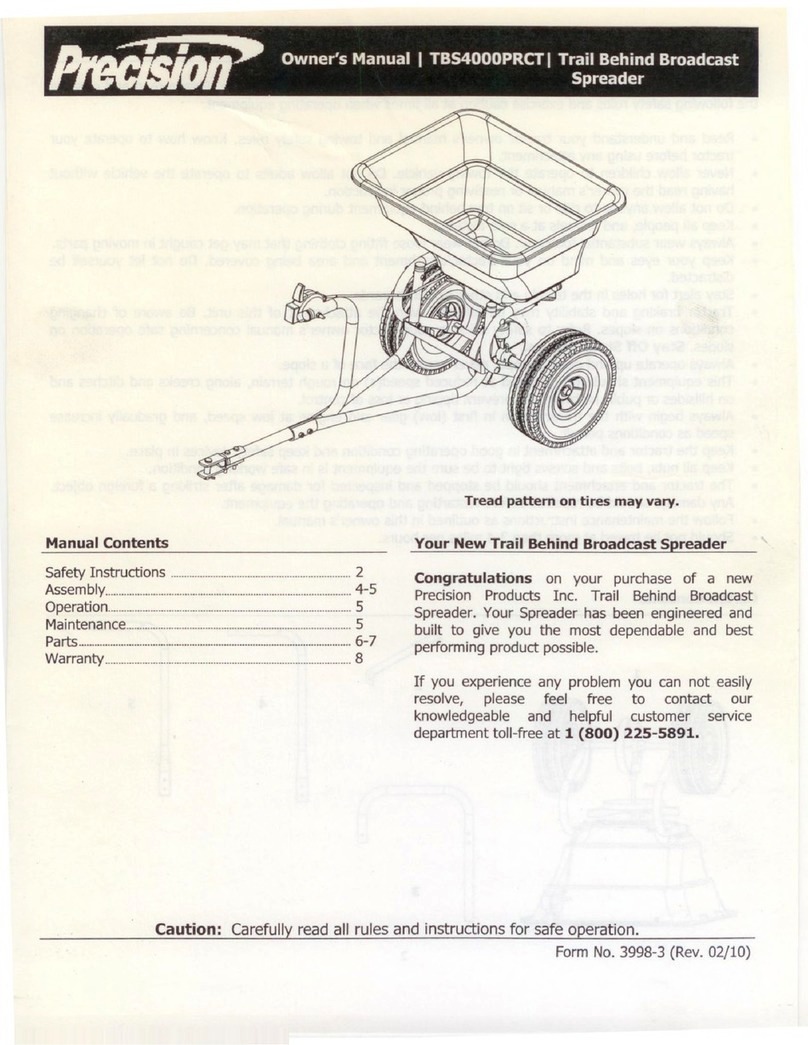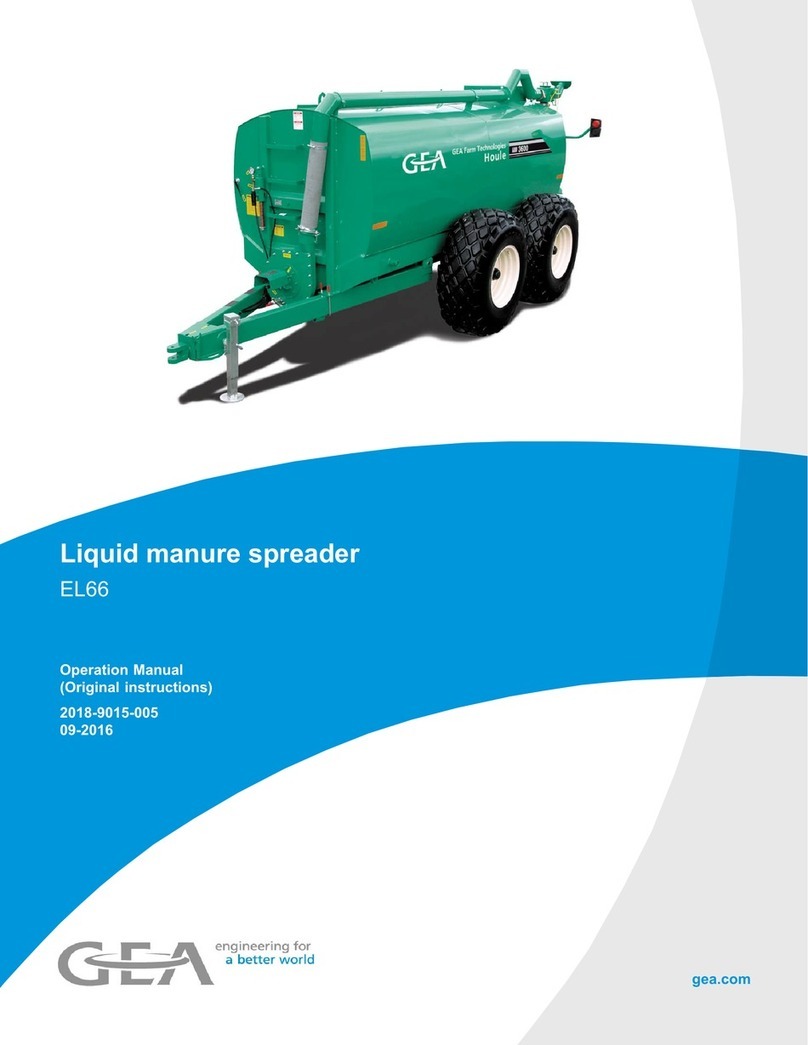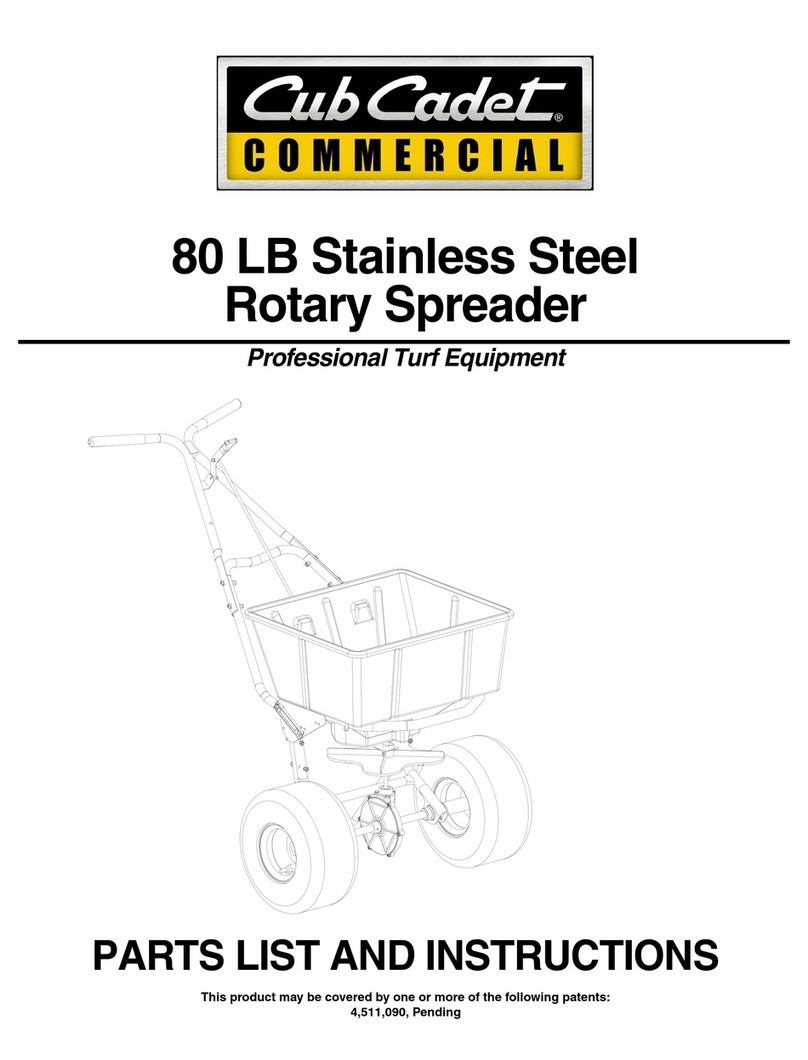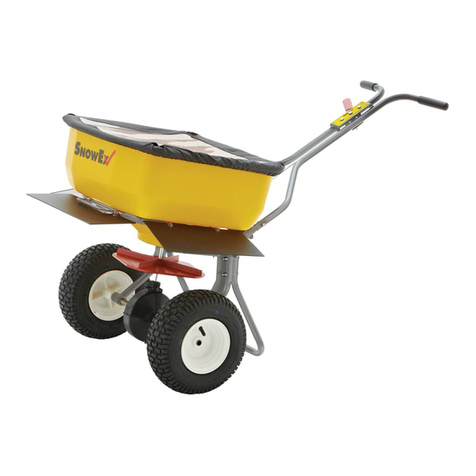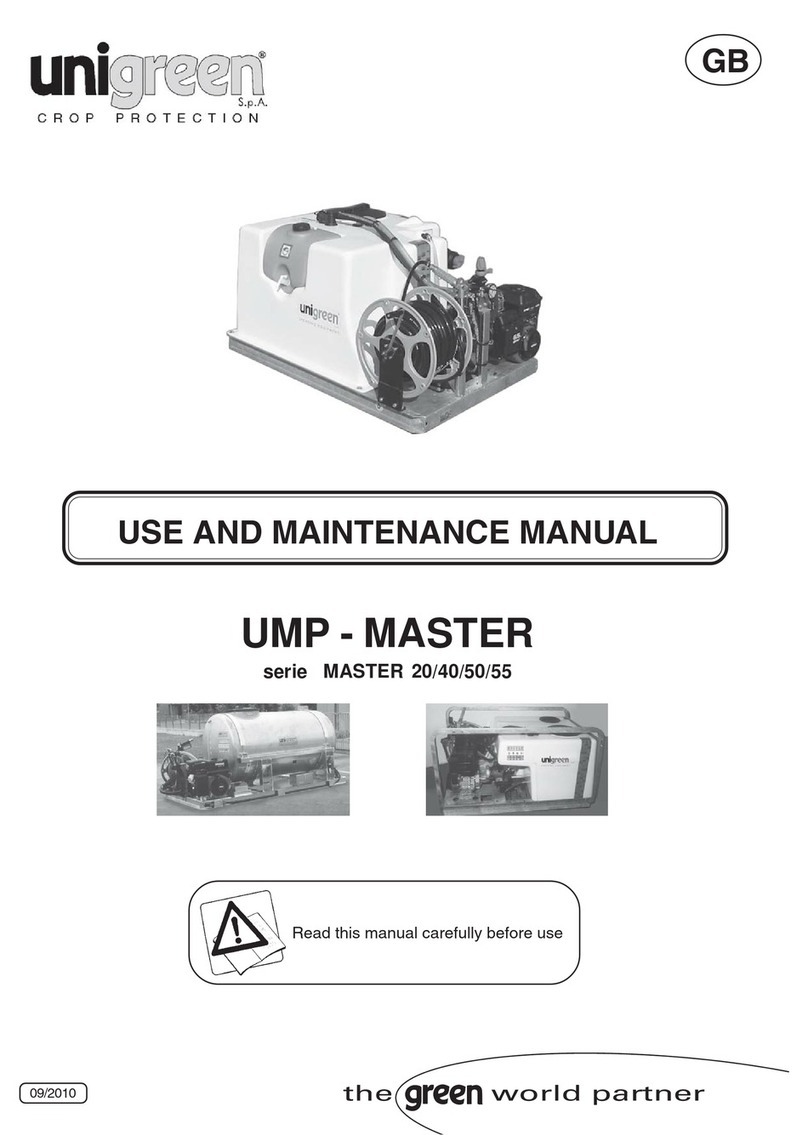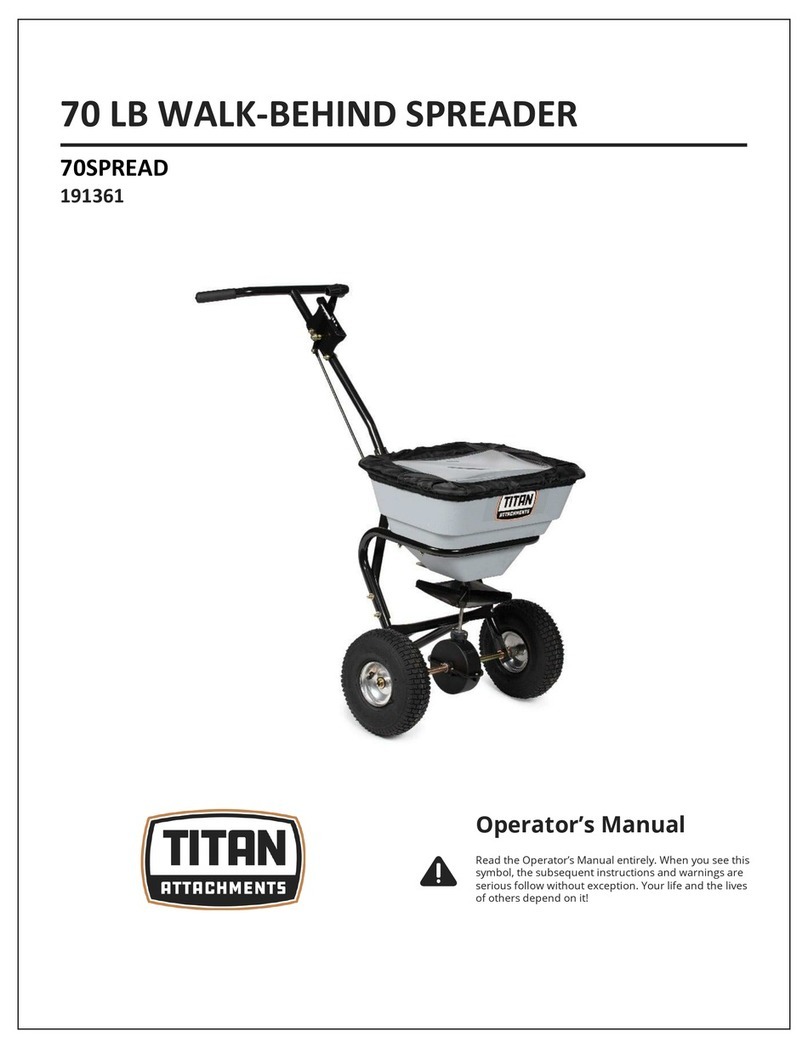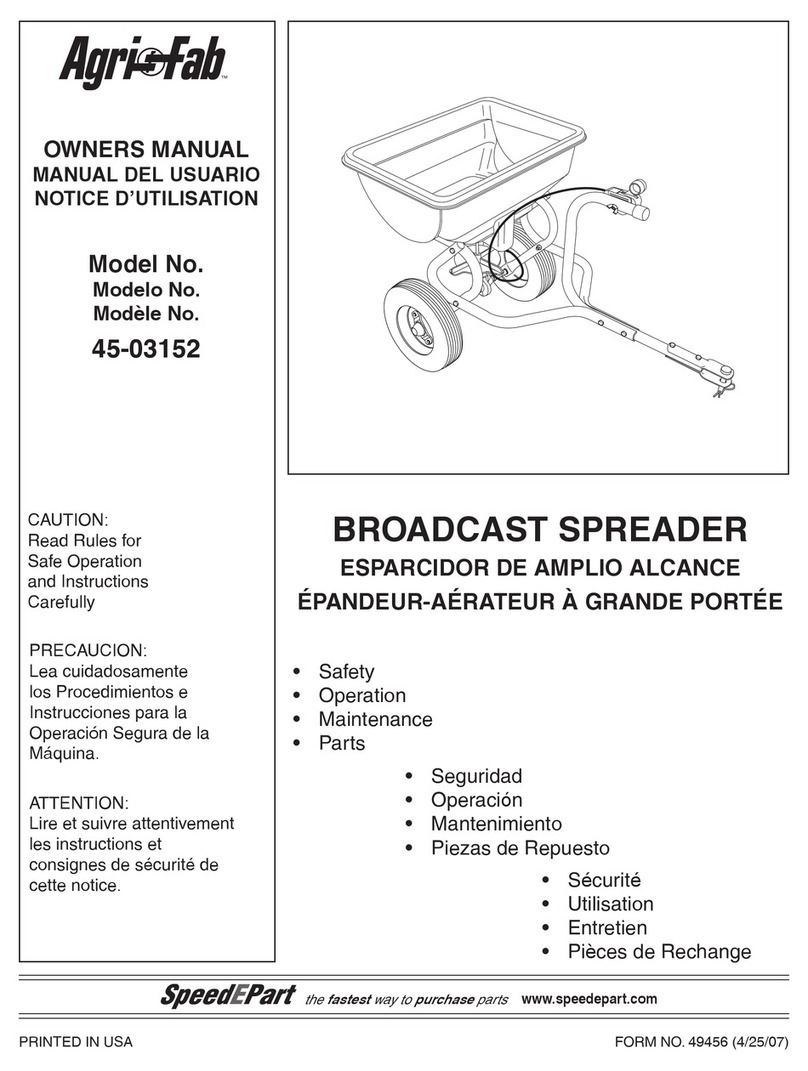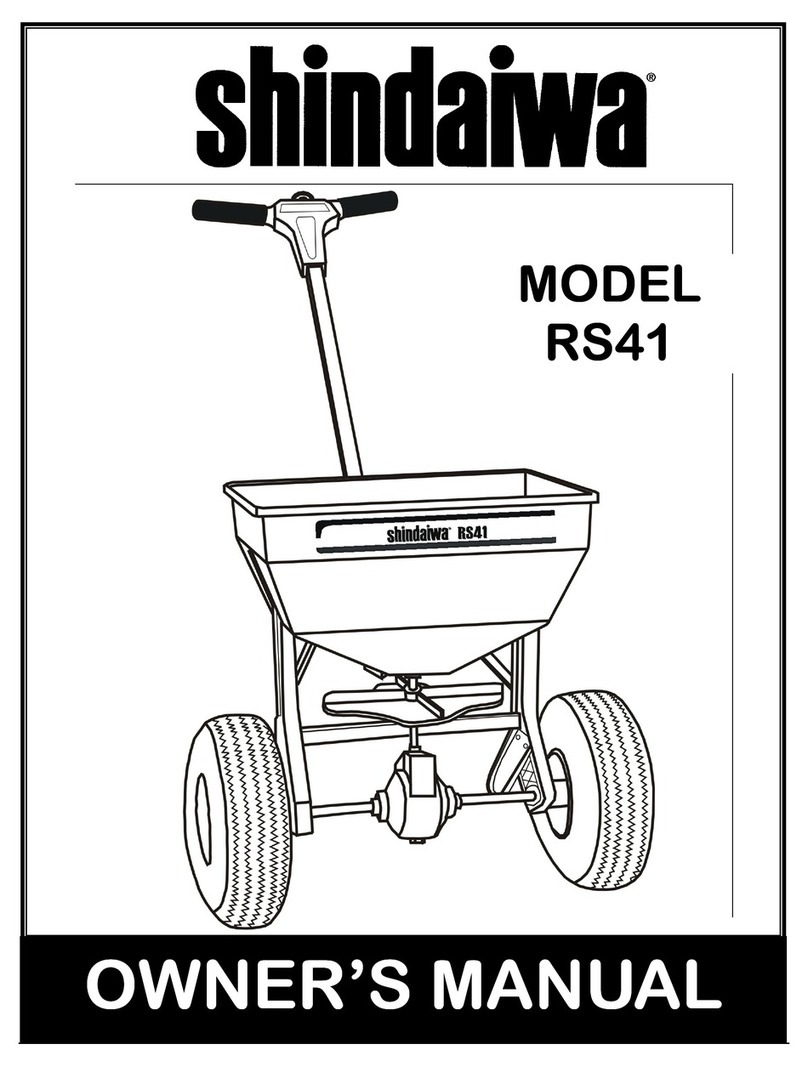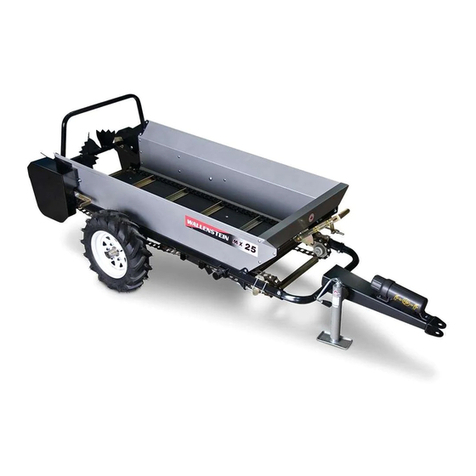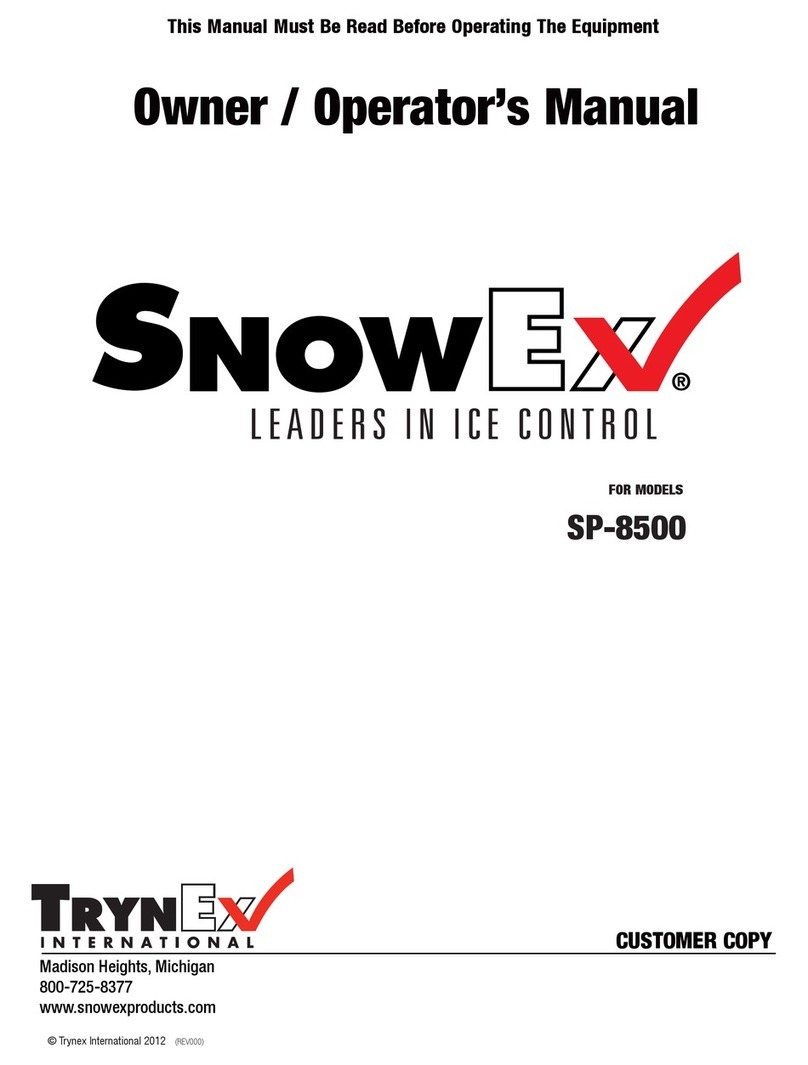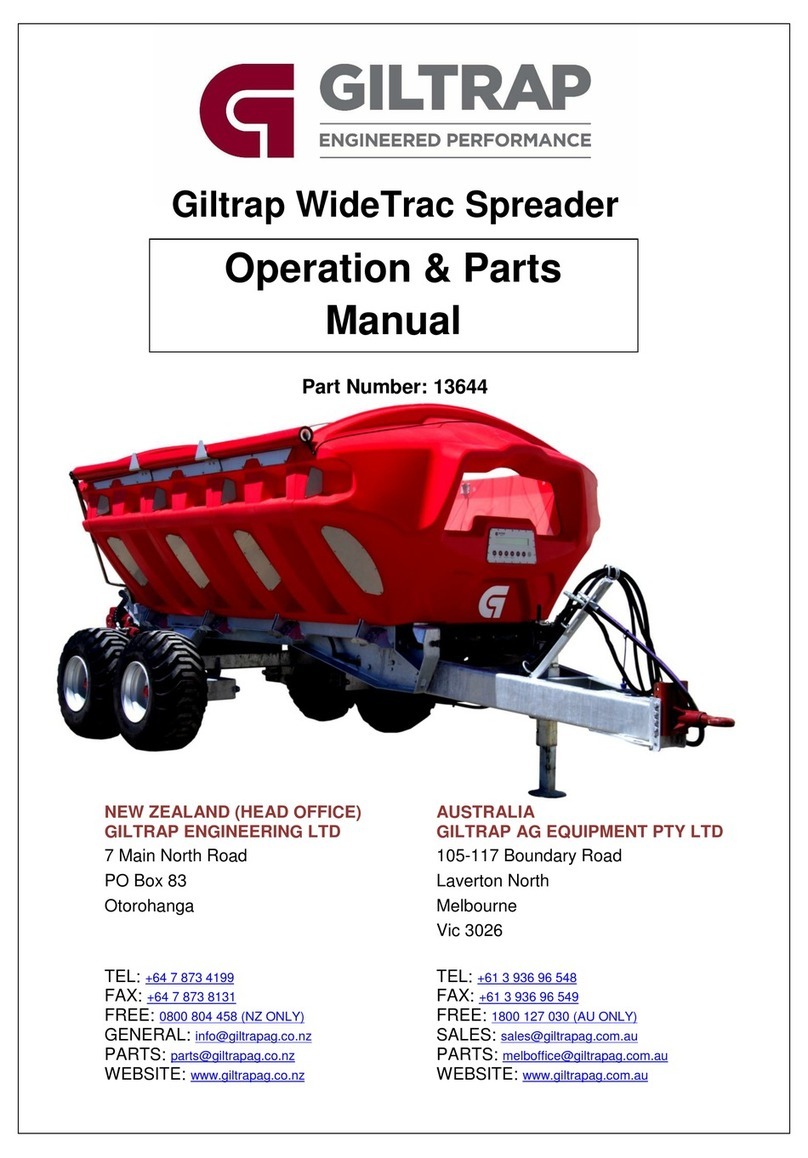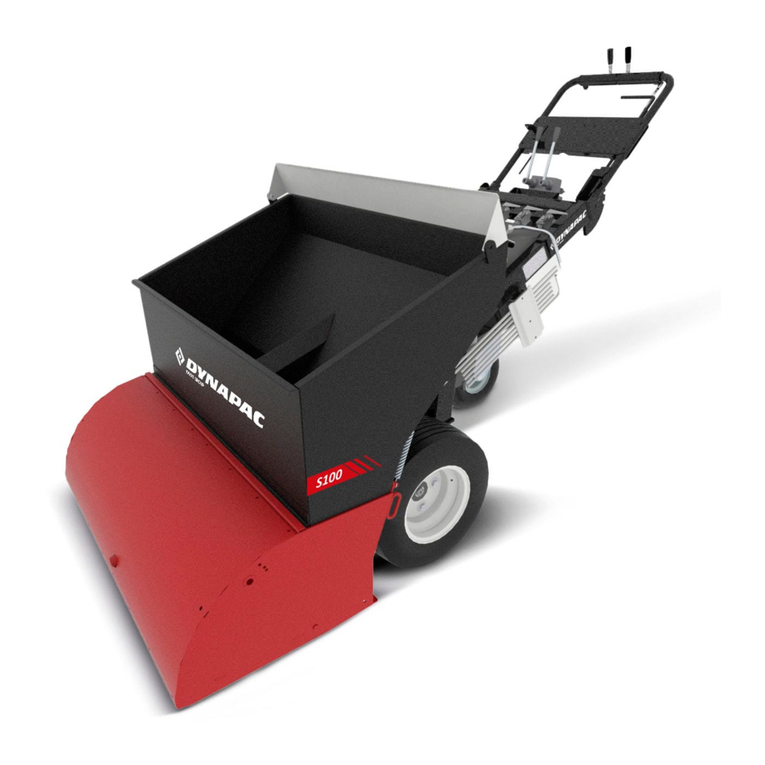Gearmore RE1000 Guide

DOUBLE SPINNER
SPREADER
Operation,
Service & Parts Manual
For Model RE1000
June 2011
Form: RE1000Spreader

TABLE OF CONTENTS
SECTION DESCRIPTION..................................................PAGE
1 Introduction.............................................................................................1
2 Preparation Checklist ..............................................................................2
3 Important Safety Information ............................................................3 - 5
3.1 Safety Decals....................................................................................................3
3.2 Operational Safety.....................................................................................4 - 5
4 Machine Description ..........................................................................6 - 8
4.1 General Description .................................................................................6 - 7
4.2 Machine Drawings & Diagrams ...................................................................8
5 Assembly Instructions ...................................................................... 9 - 10
5.1 Tractor Connection.........................................................................................9
5.2 Machine Disconnection .................................................................................9
5.3 Diagram of Hydraulic Circuit.....................................................................10
6 Adjustments .....................................................................................11 - 15
6.1 Start Up Checklist .........................................................................................11
6.2 Working Height .............................................................................................11
6.3 Adjustment of Fertilizer Spreading............................................................12
6.4 Hydraulic Opening Group ..........................................................................12
6.5 Vanes & Spreading Discs.............................................................................13
6.6 Spreading Chart.............................................................................................14
6.7 Kinetic Diagram of Motion........................................................................15
6.8 Filling Hopper ...............................................................................................15
7 Operation .........................................................................................16 - 17
7.1 Field Distribution..........................................................................................16
7.2 Spreading Variables.......................................................................................16
7.3 Adjusting Spreading Width..........................................................................17
8 Maintenance & Lubrication ............................................................18 - 19
8.1 Lubrication.....................................................................................................18
8.2 Handling & Storage ......................................................................................18
8.3 Transportation ...............................................................................................19
8.4 Accessories.....................................................................................................19
9 Parts ............................................................................................... 20 - 27
9.1 Central Gearbox....................................................................................20 - 21
9.2 Lateral Gearbox.............................................................................................22
9.3 Hopper............................................................................................................23
9.4 Opening Assembly........................................................................................24
9.5 Frame ......................................................................................................25 - 26
9.6 Spreader Discs...............................................................................................27
10 Limited Warranty...................................................................................28

1. INTRODUCTION
1
We would like to thank you for purchasing a Gearmore product and we assure you that you have made a
good choice, as now you have a very high quality machine. Please follow all instructions contained in this
manual for a long and trustworthy machine life.
Know your controls. Read this manual and the manual provided with your
tractor before operating your equipment. Keep this manual handy for ready
reference. Learn how to stop the tractor engine and spreader quickly in case of
an emergency. DO NOT allow adults without proper instructions or children
to operate machinery. Require all operators to read this manual carefully and
become acquainted with all adjustments and operating procedures before
attempting to operate the equipment. Replacement manuals can be obtained from
your selling dealer.
The equipment you have purchased has been carefully engineered and
manufactured to provide dependable and satisfactory use. Like all mechanical
products, it will require cleaning and upkeep. Lubricate the unit as specified.
Please observe all safety information in this manual and safety decals on the
equipment.
For service, your authorized dealer has trained mechanics, genuine service parts, and the necessary tools
and equipment to handle all of your service needs.
Use only genuine service parts. Substitute parts will void the warranty and may not meet standards
required for safe and satisfactory operation. Record the model number and serial number of your
equipment in the warranty page of this manual.
Throughout this manual, the term IMPORTANT is used to indicate that failure to observe procedures can
cause damage to equipment. The terms CAUTION, WARNING and DANGER are used in conjunction
with the Safety-Alert Symbol, (a triangle with an exclamation mark), to indicate the degree of hazard for
items of personal safety.
This Safety-Alert Symbol indicates a hazard and means ATTENTION!
BECOME ALERT! YOUR SAFETY IS INVOLVED!
DANGER Indicates an imminently hazardous situation that, if not avoided, will
result in death or serious injury.
Indicates a potentially hazardous situation that, if not avoided, could
WARNING result in death or serious injury, and includes hazards that are
exposed when guards are removed.
CAUTION Indicates a potentially hazardous situation that, if not avoided, may
result in minor or moderate injury.
IMPORTANT Indicates that failure to observe can cause damage to equipment.
NOTE Indicates helpful information.
It is IMPORTANT to
read this manual
carefully before
operating the
spreader!

2. PREPARATION CHECK LIST
2
THIS CHECKLIST TO REMAIN IN OWNER’S MANUAL
ITIS YOUR RESPONSIBILITY TO COMPLETE THE PROCEDURES LISTED
BELOW BEFORE OPERATING THE SPREADER
Preparation Check List
1. Implement is completely assembled.
2. Inspect for damage and loose or missing parts
3. All decals in place and readable.
4. All fittings and drive components are secure.
5. Overall condition good.
6. Check hopper for any foreign objects.
7. Operator has been instructed on the safe and proper use of the implement.
8. Lubrication - See Lubrication & Maintenance Section
The purpose of this manual is to assist you in operating and maintaining your spreader for years of service.
Read it carefully. The information and instructions in this manual have been compiled from extensive
field experience and engineering data. Some information may be general in nature due to unknown and
varying operating conditions. However, through experience and these instructions, you should be able to
develop procedures suitable to your particular situation.
The illustrations and data used in this manual were current at the time of printing, but because we
maintain an ongoing program of product improvement, we reserve the right to make improvements in
design or changes in specifications without incurring any obligation to install them on units previously
sold. Because of the possibility that some photographs in this manual were taken of prototype models,
production models may vary in some detail.
All information, illustrations and specifications in this manual are based on
the latest information available at the time of publication. The right is
reserved to make changes at any time without notice.
RETAIL CUSTOMER'S WARRANTY RESPONSIBILITY
It is the Retail Customer and/or Operator's responsibility to read the Operator's Manual, to operate,
lubricate, maintain and store the product in accordance with all instructions and safety procedures. Failure
of the operator to read the Operator's Manual is a misuse of this equipment. It is the Retail Customer
and/or Operator's responsibility to inspect the product and to have any part(s) repaired or replaced when
continued operation would cause damage or excessive wear to other parts or cause a safety hazard. It is the
Retail Customer's responsibility to deliver the product to the authorized dealer from whom he purchased
it, for service or replacement of defective parts which are covered by warranty. Repairs to be submitted
for warranty consideration must be made within thirty (30) days of failure. It is the Retail Customer's
responsibility for any cost incurred by the dealer for traveling to or hauling of the product for the purpose
of performing a warranty obligation or inspection.

3. SAFETY INFORMATION
3
3.1 SAFETY DECALS
ATTENTION!
Be sure that the safety labels are readable. Clean them using a cloth,
water and soap. Replace the damaged labels placing them in the right
position, as subsequently described.
The safety signs on the machine supply the most important indications; their observance helps your
safeness.
1. ATTENTION! Before any
intervention on the machine, 2. ATTENTION! - DANGER
switch off the tractor motor, Risk of entangling and dragging.
remove the start up key, set the Do not put hands or stay near
parking brake and carefully the moving parts.
read the operator's manual.
3. ATTENTION! To ensure the 4. ATTENTION! - DANGER
machine proper operation, the Risk of crushing due to the
tractor power take-off shall turn tractor motion. Do not stand
counter-clockwise at 540 RPM. behind the tractor.
5. ATTENTION! - DANGER
Risk of material and/or objects 6. ATTENTION! - DANGER
projection due to fertilizer of shearing. Do not approach
spreading. Keep yourself at a limbs to the pendulum when
safe distance of at least 30 ft. the machine is running.
from the machine.
7. ATTENTION! Mandatory use of protection gloves and shoes.
Placement of safety decals on machine:

4
3. SAFETY INFORMATION (continued)
3.2 OPERATIONAL SAFETY
Guards and safety shields are for your protection. DO NOT operate equipment unless they
are in place.
ALWAYS engage tractor PTO at engine idle.
Disengage tractor PTO and shift into neutral before attempting to start engine.
Read and observe all safety decals on the tractor and spreader.
NEVER allow anyone, other than the operator, within 25' of machine while in operation.
DO NOT stop or start suddenly when going uphill or downhill. Avoid operation on steep
slopes.
Be alert for holes in terrain and other hidden hazards. ALWAYS drive slowly over rough
ground.
Reduce speed on slopes and in sharp turns to prevent tipping or loss of control. Be careful
when changing directions on slopes.
Take all possible precautions when leaving tractor unattended: Disengage PTO, lower
spreader, shift into neutral, set parking brake, stop engine and remove key from ignition.
Front tractor weights or front tire ballast should be used to enhance front-end stability on
small tractors.

Risk of being entangled due to rotary driveshaft connecting
the tractor - machine.
Compression and crushing (being entangled) due to contact
with the stirrer rotating inside the hopper.
Compression and crushing due to presence of motion
distribution chains and pinions.
Any reset operation must be carried out with the tractor engine
off, power take-off disconnected, parking brake on, and start-up
key removed from the panel.
Cuts and abrasions due to contact and handling of blades, discs,
distributors and driving elements during reset operations.
Use shear-proof gloves.
5
3. SAFETY INFORMATION (continued)
3.2 OPERATIONAL SAFETY (continued)
ATTENTION!
Any maintenance, adjustment and cleaning operation must be carried out with the machine lowered to
the ground (in stable conditions), the tractor engine off, power take-off disconnected, parking brake on,
and start-up key removed from the panel.
Machine start-up and stop controls are those of the pulling tractor; the machine is not equipped with
controls.
While removing solid parts of fertilizer, the machine must be disconnected from the tractor. For this
operation, use the specific tools.
In case of failure or improper operation, the operator must immediately stop the machine, check the
problem and adopt any necessary measure.
HAZARDS, PREVENTION AND PROTECTION MEASURES

4. MACHINE DESCRIPTION
6
4.1 GENERAL DESCRIPTION
The fertilizer spreader with centrifugal distribution is a machine
for agriculture that spreads in the field solid mineral fertilizer in
granular and powder form. It is pulled by and coupled to the tractor
by three points.
The fertilizer spreader consists of:
●A bearing chassis
●One hopper designed to contain the product to be spread
●Distribution components, driving and adjustment components
In the front side, the machine is equipped with a coupling
structure with three coupling points to the tractor.
The hopper in metal sheet has a truncated conical shape.
The fertilizer contained in the hopper goes through the dispenser
and, due to gravity, falls on the distributor - spreader system.
The dispenser is equipped with hydraulic controls to
open and close.
The amplitude of the dispenser opening is manually, adjusted
with a lever whose position is fixed on a knob.
The distributor - spreader system consists of two horizontal
discs with rotational motion; on their upper surface is a series
of straight radial fins designed to distribute the product by means
of centrifugal force.

4. MACHINE DESCRIPTION (continued)
7
4.1 GENERAL DESCRIPTION (continued)
Each spreading disc is connected to the machine driving
motion by a support pin with fixing knob to be tightened
by hand accurately.
The disassembly of the discs, operation necessary to allow
thorough cleaning of the hopper, should be carried out by
reversing the assembly sequence or by unscrewing the
fixing knob and removing the discs.
Safety devices are provided to avoid any contact with live parts in
motion and to prevent any projection of material outside the working
area, in detail:
●The agitator into the hopper is protected by a grid
The protection grid is fixed to the frame by means of 4 cotter pins. The disassembly is necessary just for
the replacement of the agitator or for the cleaning of the internal part of the hopper.
●The driving system is protected by fixed protections
●The distribution rotary discs are protected by a
fixed shaped bar
●In the front (tractor side) a fixed protection
prevents any projection of material outside
the working area

4. MACHINE DESCRIPTION (continued)
8
4.2 MACHINE DRAWINGS & DIAGRAMS
1. Hopper
2. Chassis and coupling points to the tractor
3. Opening and distribution unit
4. Rotary spreading discs and blades
5. Opening grid (of the agitator into the hopper)
6. Fixed rear protection (of spreading discs)
7. Fixed front protection (protection towards the tractor driver)

5. ASSEMBLY INSTRUCTIONS
9
5.1 TRACTOR CONNECTION
Connect the machine to the tractor as follows:
●Place the machine on a pallet about 8" high for easy coupling to the tractor (this will also
help handling the unit itself)
●Go backwards with the tractor near
the lower machine coupling points
●Anchor the lower coupling points of
the tractor to those of the machine
through the pins and secure them with
safety pins
●Simple couple the upper coupling point
of the machine to the third point of the
tractor through the pin and secure with
safety pin
●Raise the machine a few centimeters and stop the lower lifting bars to prevent any potential
oscillations during the work
●Disconnect the power take-off and stop the engine and activate the parking brake of the tractor
●Connect the driveshaft to the spreader reduction gear shaft and then to the power take-off of
the tractor
●Connect the hydraulic system
5.2 MACHINE DISCONNECTION
Disconnect the machine from the tractor as follows:
●Place the machine on the ground (on a compact and leveled ground), checking the stability on the
supporting points; place the machine on a pallet about 8" high for easy handling and following
coupling to the tractor
●Close the fertilizer outputs
●Disconnect the power take-off
●Switch the motor off and activate the parking brake of the tractor
●Disconnect the hydraulic system
●Disconnect the driveshaft from the tractor power take-off and then from the spreader reduction
gear shaft
●Disconnect the upper pin and the two lower pins of couplings and move the tractor forward

5. ASSEMBLY INSTRUCTIONS (continued)
10
5.3 DIAGRAM OF THE HYDRAULIC CIRCUIT

6. ADJUSTMENTS
11
6.1 START UP CHECKLIST
IMPORTANT!
Before every start-up, check the following safety devices:
●Guards of the driveshaft
●Guards of the hopper agitator
●Fixed guards (of rotary discs, against projection of material towards the tractor, of the drive
elements)
●Fixing knob of rotary spreading discs
Do not load the hopper over the edge to avoid the loss of fertilizer during the work and travel.
Proper hopper filling - the fertilizer does not exceed the hopper edge
Improper hopper filling - the fertilizer exceeds the hopper edge
6.2 WORKING HEIGHT
32 Inches between the ground
level and the distribution disc
height.

6. ADJUSTMENTS (continued)
12
6.3 ADJUSTMENT OF FERTILIZER SPREADING
Adjustment and total fertilizer output opening; the output control system is independent for each disc.
There is a plate (Fig. A) on which there are two levers - one on the right and one the left. The levers are
used to adjust the amount of fertilizer to be spread. After checking on the spreading chart (See Page 14)
the number to be adjusted, move the levers and lock them on the number indicating the desired amount.
When the levers are as shown in picture A, the fertilizer output is wide open. Contrary, when the levers are
as shown in picture B, the fertilizer output is closed. Adjustment and fertilizer output opening only on one
side (left or right) - if the fertilizer must be spread only on one side, just set the levers so that only one of
them makes the opening (Fig. C). With the machine rear side in front of you, open the left levers to spread
from left hand side and vice-versa.
6.4 HYDRAULIC OPENING GROUP
The machine is provided with hydraulic cylinders that
operate the opening of the distribution system.
The hydraulic cylinder is "to simple effect" type (the
distribution opening is due to the oil presence).
Dosage adjustment - To make an adjustment of the dosage (fertilizer
quantity per acre) there is a split system - the right spreading disc is
provided with an adjustment system, separate from the left one. To obtain
the adjustment of the dosage you have to move the adjusting slot lever for each disc. Each adjusting slot is
provided with a measuring scale with 18 dosage positions. The 0 position means "shut" (Pic A below); to
raise the spreading move gradually the lever toward the external side. The 18 position means "max". The
presence of two separate controls allow to spread in a different way on the right side and on the left one
(Pic. B below). To move the lever you have to screw the adjusting knob off, set the lever in a desired posi-
tion and screw the knob again (Pic. C below).

6. ADJUSTMENTS (continued)
13
6.5 VANES AND SPREADING DISCS
The vanes come assembled to the spreading discs. These vanes are set at position 2.
The spreading chart on the next page is based on position 2.
Ref. A
Ref. B
Ref. C

6. ADJUSTMENTS (continued)
14
Ref. E
6.6 SPREADING CHART

6. ADJUSTMENTS (continued)
15
6.7 KINETIC DIAGRAM OF MOTION
6.8 FILLING HOPPER
IMPORTANT! - Take special care when you set up the spreading
width in order to avoid spreading in an area where you could
contaminate fivers, streets and other cultivations or habitations.
Fill the hopper and prepare the spreading as follows:
●Set the hydraulic opening lever in shut position
●Switch the tractor engine off, disconnect the PTO, set the handbrake on and
remove the start-up key from the panel
●Adjust the dosage by means of the levers by the discs.
●Adjust the spreading width changing the vanes position or size
●Fill the hopper with the fertilizer
●Switch on the engine of the tractor and connect the PTO
●Set the hydraulic opening lever in working position (open)

7. OPERATION
16
7.1 FIELD DISTRIBUTION
●Place the tractor at the beginning of the field (Position 1). The distance from the border has to
be the same as the spreading Ref R.
●Move along the field perimeter keeping the R distance from the border as long as you arrive in
the position 2. In this position you have to be at the R distance from the position 1.
●Go along till the position 3.
●Make a 180° turn, place the tractor in position 4 at the R distance from the position 3 and go
along till the position 5.
●Repeat this procedure until you have spread the entire area of the field (positions 6 and 7).
7.2 SPREADING VARIABLES
●The quantity of fertilizer spread depends on the tractor speed, the spreading area, fertilizer type
and humidity, weather conditions and from the adjusting machine.
●Keep the tractor speed constant while working.
●Preserve the fertilizer in a way to keep its features from being altered.

17
7. OPERATION (continued)
7.3 ADJUSTING SPREADING WIDTH
The spreader can be adjusted so that it can spread to different widths and with different types of fertil-
izers. To make this possible you have to operate on the RPM of the PTO and on the vanes position. The
machine is delivered and set to spread to 59 feet.
In order to achiever a good result, first run with the machine spreading only from one side, thus dis-
abling one spreading disc. The spreading will be completed with further runs.
For the next steps you have to use both discs.
If the remaining spreading area is less than 59 feet, you have to adjust one disc in order to spread in a
right way and do not spread in the closer area.

8. MAINTENANCE & LUBRICATION
18
8.1 LUBRICATION
Any maintenance, adjustment and cleaning operation must be carried out with the machine lowered to
the ground (in stable conditions), the tractor engine off, power take-off disconnected, parking brake on
and start-up key removed from the panel.
Before every use and after 8 hours of real operation, grease the driving unit. It is recommended to
clean the greasing points from mud and other residual materials before injecting the grease.
Grease points (shown below) using lubrication grease EP1.
The driveshaft must be lubricated before the spreader is put into use. After that, grease every 8 hours. It
is also necessary, from time to time, to untelescope the driveshaft to clean and re-grease tubings. Grease
the gearbox every 40 hours.
8.2 HANDLING & STORAGE
Cleaning -
●Wash hopper with water after each use.
●Never let material build up on shutters or in the hopper
●Check spreader for needed repairs before using again
Storage - If your spreader will not be used for a long period of time, respect the following suggestions:
●Wash the machine thoroughly and dry it.
●Lubricate all bearings with enough grease to eliminate any cavities where water condensation
may occur and cause damage. Refer to "Maintenance Section" for location of all grease fittings.
●Coat all exposed surfaces inside the spreader with oil or grease to prevent rusting and pitting
during storage.
●Protect the whole machine with a tarpaulin and put it in a dry place away from activity.
Table of contents
Other Gearmore Spreader manuals
